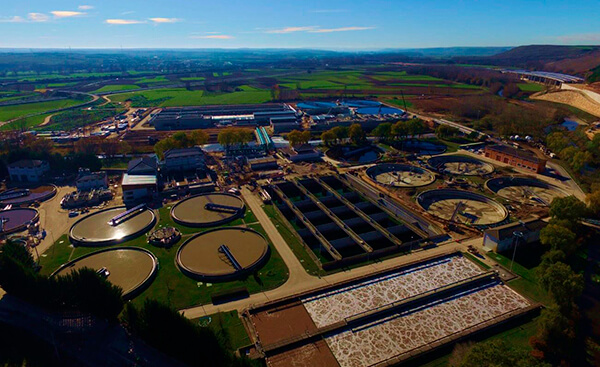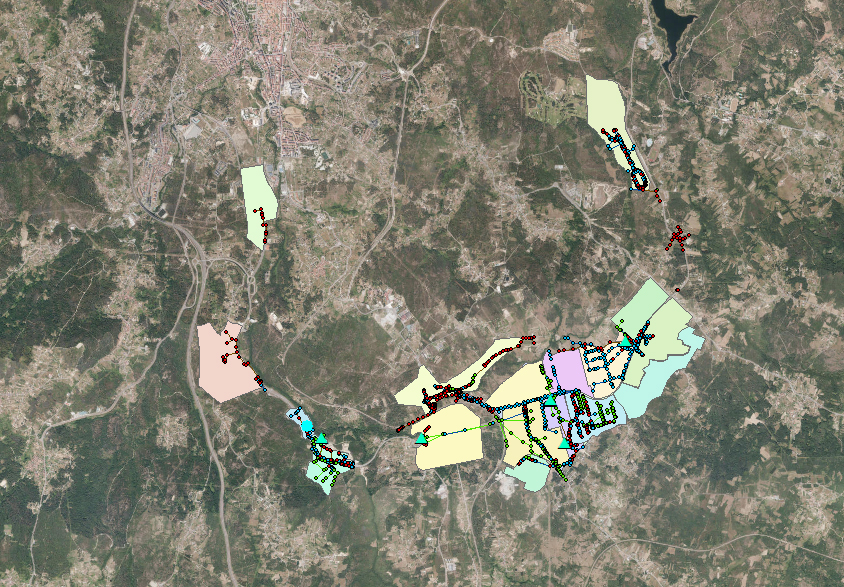
Water
W.W.T.P.
INNCIVE has extensive experience in the Development of Wastewater Treatment Plants throughout the world. INNCIVE is currently carrying out the constructive project of W.W.T.P. of Buenos Aires Tenerife (Spain) for JOCA-Alpi, the preliminary project of the W.W.T.P. of Matalascañas for the Ministry of Ecological Transition (Spain), the project of the WWTP of San Cibrao for the Direction General del Agua and the Confederation of the Miño Sil (Spain), as well as the construction project of the WWTP of the airport of Lanzarote for ELECNOR – Aena (Spain).
INNCIVE has developed all kinds of depuration processes such as Bacterial beds, Prolonged Oxidation, Active sludge, Active sludge with nitrogen and phosphorus reduction, Biofiltration, MBR, MBRR.
The objective pursued by the design of a W.W.T.P.. is to define the works and facilities necessary to make it possible to purify the wastewater of a specific population, as well as the treatment and final disposal of the waste generated, taking into account the environmental impact conditions, the location of the plant and the receiving channel.
The objectives in the treatment of wastewater should be closely linked to the objectives of the authorities in terms of improvement and conservation of water quality.
It is also important to keep in mind the existing legal provisions on issues of discharge authorization, water reuse, sludge, occupational health and safety, biological risk, waste and air.

WWTP BURGOS (ESPAÑA)

WWTP HELLIN (ESPAÑA)
WATER DESALINATION PLANTS
W.D.P
INNCIVE has extensive experience in the Development of Desalination Plants throughout the world. He has recently participated in the Detail Engineering Design of the Jors Laffar Treatment Plant in Morocco and in several tender projects in the rest of the world such as SWRO de Taweelah (U.A.E.), S.W.R.O. of Al Shuquaiq 3 (K.S.A.) or S.W.R.O. of Mamelles (Senegal).
Reverse osmosis (RO) is a process in which fresh water is obtained from salt water. Natural osmosis is a phenomenon that, if there is a semipermeable membrane separating two solutions with the same solvent, the solvent passes through it, but not the dissolved salts, from the side where the concentration of salts is lower towards the highest, until on both sides of the membrane the solutions have the same concentration. This process is carried out without the contribution of external energy, and is generated by what is called osmotic pressure.
The reverse osmosis is to pass through the semipermeable membrane the solvent (in this case water) from the side where the most concentrated solution (sea water, with dissolved salts), to the opposite side, without passing the salts. In this case, energy is required, in the form of pressure, which will be slightly higher than the osmotic pressure that would pass the low concentration solvent towards the high concentration side. The pressure required to achieve reverse osmosis depends on the amount of dissolved salts and the degree of desalination you want to obtain. The increase in entropy results from the use of energy in the process.
The sea is a virtually unlimited source of salt water. A reverse osmosis plant needs to process a volume of seawater up to three times greater than the total amount of desalinated water that will be obtained at the end.

SWRO SFAX (TÚNEZ)

SWRO BARKA (OMAN)
POTABLE WATER TREATMENT PLANTS
W.T.P.
INNCIVE has extensive experience in the Development of Potable Water Treatment Plants throughout the world. He has recently participated in the Design of the Detailed Engineering of the Expansion of the Water Treatment Plant of Belgrano in Buenos Aires (Argentina).
Potable Water Treatment Stations are facilities that convert natural or raw water into drinking water. They are located between the water collection facilities (sources, rivers, reservoirs and wells) and the deposits and channels that will distribute it through the homes.
Their mission is the elimination of three main types of undesirable substances in water intended for human consumption:
- Mineral matter
- Organic materials: phenols, hydrocarbons, detergents, pesticide residues …
- Biological contaminants: microorganisms such as bacteria, protozoa, viruses …
This need for water treatment has been known for a long time, since water quality is related to the health of the population. It was observed that the allocation of a locality with a water supply in acceptable sanitary conditions coincided with a sharp decrease in the mortality rate. Each year more than 2.2 million people die, most of them from developing countries, because of diseases related to poor water supply and sanitation conditions.

WTP ESMERALDA (COLOMBIA)

WTP GAMBOA (PÁNAMA)
INDUSTRIAL WASTE WATER TREATMENT PLANTS
I.W.W.T.P.
INNCIVE has extensive experience in the Development of Industrial Wastewater Treatment Plants. We have developed in the last years many studies for industrial plants in cheese factories, wineries, beer plants, plants with agricultural and textile developments.
Industrial Water
They are the waters from activities related to the industry (preparation of raw materials, processing and finishing of products, as well as the transmission of heat and cold).
In addition to the characteristic components of urban waters, the industrial substances (toxic substances, metal ions, chemical products, detergents, hydrocarbons, radioactive products, etc.) may appear in industrial water discharges. The great variety and quantity of compounds discharged by this type of activity, requires an own investigation for each type of industry, since there is no similarity between discharges from food, chemical, agricultural, metallurgical industries, etc.
Waters of agricultural origin
They are water from agricultural and livestock activities. The contamination of this type of water is very important, given the high concentration that it can have.
In addition to containing substances similar to discharges of domestic origin, they may contain products characteristic of agricultural activity such as: fertilizers, biocides, manure, etc. Regarding fertilizers, note that before they were of organic origin and today they have been almost replaced by fertilizers of inorganic origin, such as sulfates, nitrates, phosphates, etc., of special incidence in water pollution. Except in the case of discharges from intensive livestock farms, pollution of agricultural origin is usually diffuse in the territory and affect the soil and aquifers under the affected area. This characteristic makes it a contamination of very difficult treatment, being preferable the prevention.
Residues of agricultural origin require specific studies for their treatment.

PLANTA JORS LAFFAR (MARRUECOS)

IWWTP DAMMAM 3 (ARABIA SAUDI)
WATER REUSE AND REGENERATION STATIONS
W.W.R.T.P.
INNCIVE has made several Regenerated Water Plants over the last few years as well as Supply and Sanitation Plans that include all types of hydraulic infrastructures and studies similar to those that will be developed in this project. In the same way, he has participated in several projects in which part of the infrastructure through which the reclaimed water of Madrid is moved has been developed, so he knows the different areas and facilities. Below are the most relevant ones:
• Executive project of the regenerated water interconnection network of the gavia
• Technical and environmental assistance, monitoring and control of connection works for treated water from the sewage treatment plant of Gavia to the sewage treatment plant in China and referral to the Entrevías forest park (p.f.e) (Madrid).
• Services for the preparation of the preliminary draft for the reuse of treated wastewater from the sanitation of the Santander Bay (Cantabria)
• Formentera Supply and Sanitation Director Plan
• Water Sustainability Plan in the urban uses of Menorca
• Municipal Sanitation Plan of Ibateguara
• Municipal Sanitation Plan for the microregion of the Seridó Oriental
• Preparation of the definitive study and technical file of the project for the expansion and improvement of the potable water and sewerage system for the Pachacutec macro project of the Ventanilla District. stage I. (Peru)
Reclaimed water is a suitable source to replace first-use resources in uses that do not require such a high level of quality. Many urban, commercial, industrial, and, of course, agricultural water applications can be met with a quality lower than potable.
Irrigation of lawns, parks and medians of public roads; water used in air conditioning and cooling towers, in some industrial processes, in the hygiene of sanitary services, in construction, cleaning and maintenance; the waters used in fountains and other ornamental uses, in environmental and recreational applications, are some examples of potential uses of reclaimed water that require potable water quality levels. Direct reuse for human consumption is not, even today, an available option, given its special impact on public health.

WWRTP SUR ORIENTAL

WWRTP LA GAVIA CONEXIÓN
POTABLE WATER SUPPLY NETWORKS
RESIDUAL WATER SANITATION NETWORKS
INNCIVE has developed in recent years more than 14 supply and sanitation plans between Spain, Peru and Brazil. The most recent are the Supply and Sanitation Plans of Lanzarote (Spain) and Villamayor de Calatrava (Spain). It is currently closing with its subsidiary INCIBRA the Sanitation Plan for 5 cities and Goiana for COMPESA in Brazil.
If the saying “Water is life” is taken into account, it is easy to explain why human settlements were located where this element was available. With the passage of time and due to population growth, it has been necessary to carry out larger-scale works every day in order to supply this precious liquid to the populations that request more and better quality every day, for their needs.
But, supplying water to human conglomerates, has as a consequence the removal of most of it, once it has been used and therefore contaminated.
For this it is necessary that the civil engineer takes into consideration a series of elements, that allow him through studies and specialized works to satisfy effectively and sustainably the need that one has of the water service, providing it in an uninterrupted way, in quantity and with the proper quality.
One Important point to be considered is the remoteness of the sources of supply, motivated mainly by the location of water on our planet, which is usually already isolated from urban centers.
In the same way, the eviction of the water that was already used, is necessary to avoid water-borne diseases to the population, always taking care not to contaminate the sources that other communities use for their supply.

MECO (ESPAÑA)

SAN CIBRAO (ESPAÑA)

